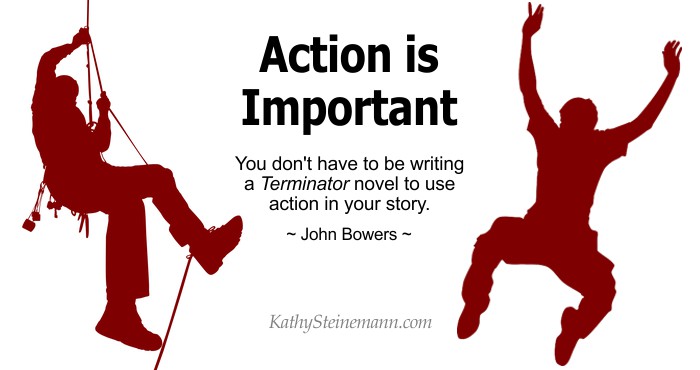
Every Novel Contains Action
Whether a character is walking, talking, crying, writing, (or crying while writing), you can find several ways to describe that character’s actions. And objects in that character’s environment can move, land, shine, disappear, or …
In another guest post by John Bowers, we discover how to portray actions in a way that engages readers.
—
The Art of Description Part Three
I believe that description is the key to making a novel unforgettable. Even if the story itself isn’t your cup of tea, reading a book packed with vivid descriptions is likely to leave an imprint in your mind long after you have put it down.
In the first two parts of this series, we covered describing People and Scenery (or settings). This final entry will concentrate on describing Action.
Describing Action
Not all books or movies are “action stories,” yet they all contain some kind of action. People move about; they talk; they work, play, or fight. All of these elements are some kind of movement, of action. You don’t have to be writing a Terminator novel to use action in your story.
To describe action requires verbs. We all know that verbs come in two primary categories — verbs of being and verbs of action (there are others, but we’ll concentrate on these two). I still remember the “verbs of being” from sophomore English class in 1965 (we were made to memorize them): is, ist, am, amt, are, art, was, wast, were, weret, be, being, been (including a few archaic terms from Merrie Olde England). Verbs of being simply describe something that exists without telling you anything else. You can’t do much with these except use them as they are.
Action verbs are a whole different story. The possibilities that action verbs provide are limitless, and using them with imagination can transform your story the way electricity transforms a civilization. Let’s look at some simple examples.
Simple Action Verbs
Except for the ill, old, or infirm, everybody walks. So you could say: Joe walked down the street. Simple enough, right? Also completely without imagination. The mere act of walking doesn’t impress anyone, but you can spice things up simply by choosing a different verb. Joe strolled down the street. Joe strode down the street. Joe paced down the street. Each of these verbs is synonymous with walking, yet each evokes a slightly different image.
The same is true if Joe is running. Joe ran down the street. Joe jogged down the street. Joe raced down the street. Joe sprinted down the street. Joe dashed down the street.
The English language is top-heavy with verbs that evoke just about anything you can imagine. If you haven’t already, check out Roget’s Thesaurus for a mind-numbing list of possibilities.
Probably the worst thing you can do is say that Joe went down the street. “Went” is a verb, sure enough, and it describes action. It is also limp and lusterless, almost completely benign. “Went” might work okay if you’re describing someone working in a hospital or warehouse — Joe went into the storeroom — but for anything more exciting, such as a war or sporting event, you need verbs with a pulse.
Let’s Try an Example
Here is a battle scene where a future fighter pilot is ambushed and outnumbered. I could have written it this way:
One of the Sirians made a second pass, this one straight at him. Johnny saw it as he turned to the right. He heard a sonic boom and his QuasarFighter jerked. Three more Sirians attacked him from the left, firing lasers as they competed for the kill.
Instead, I did this. Notice the difference in verb choice and how it improves the excitement:
Blue lasers blinded him as one of the Sirians made a second pass, this one down the throat. Johnny took a retinal snapshot of the enemy fighter filling his windscreen as he rolled to the right in a panic turn. Again, the sonic thunderclap rocked him, and his QF staggered in spite of its speed. Dimly, he was aware of three more Sirians turning in on him from the left, blue pulse-lasers smoking past his cockpit as they competed for the kill.
Both paragraphs describe exactly the same action, but which one would you rather read? Which one fires the silver screen in your head? Which one makes your heart beat just a little faster?
Action verbs! Gotta love ’em!
The Writer’s Lexicon series
and additional resources on my Facebook page.
Another Example
As I said in Part 2 of this series, readers already have images in their heads from a lifetime of videos and personal experience. All you need to do is activate those images with the correct verbs.
The following example is one of my favorites from my novel Star Marine! (yes, another shameless plug for my own novel); an invasion force is making an assault on a foreign planet, using a local airport as a beachhead:
The Lincoln landers descended steeply like geese landing on a lake. They hit the main runway and two parallel taxiways, all seven landing within thirty seconds. Before the first one touched down, a volcano of ground fire streamed up to meet them. One lander lost a wing and rolled out of control, crashing in a fireball fifty yards to the left of the runway. The rest crunched down safely, but were riddled with heavy ASC fire before they could disgorge troops. Four caught fire as they rolled to a halt, and one exploded. Star Marines spilled out the exits and were shot to pieces on the ground, arms and legs catapulting every which way; panicked pilots poured on thrust and struggled to get airborne even before the Star Marines finished unloading.
The second wave descended into an inferno of burning landers and ASC fire; shredded Star Marines decorated the pavement. The lead ship, carrying Delta Company, touched down heavily and began to skid as ground fire churned the pilot into hamburger. The co-pilot managed to fire reverse thrust, then he was killed, too. Converging streams of steel chewed into the lander from three directions as it swept sideways off the runway, the wing and nose jets competing for control.
The skid stopped only when ground fire blew off the landing gear. The Lincoln lander collapsed onto its belly and sat shuddering under conflicting thrust from its jets.
These abbreviated paragraphs contain more than just action verbs — they also make use of colorful nouns and adjectives — but the verbs are anything but benign. If you’ve ever seen a really good war movie or documentary — or experienced it for yourself — you can appreciate the urgency of what is happening.
Use Just the Right Verb
By definition, an “action story” is one that moves quickly, with emphasis on action, conflict, and heroism. But even a story like that can be boring if the same tired old verbs are used every time to describe that action (or the same tired old nouns to describe people and places). To put octane into that story you need verbs that smoke, verbs that convey the action in the most dramatic way possible.
Almost any action you want to describe can be done at various levels of dramatic impact. As we saw earlier, you can walk, stroll, stride, or pace; you can run, jog, sprint, race, or dash. Any and all of these are valid, but the more exciting you want your scene to be, the more active the verbs you need. You can talk, yell, shout, or scream. You can cry, weep, sob, or wail. Volcanoes can go off, explode, erupt, or blast. Earthquakes can shake, rattle, rumble, roll, or slam. Birds can fly, flit, weave, or soar.
And each of those examples has even more options. For added variety, use adverbs to modify them even further (see my previous article on adverbs). To tell your story in a manner that readers will remember for years afterward, choose just the right verbs and blend them into your other descriptions to create an unforgettable action sequence that will rival anything Hollywood can produce.
However …
Moderation
As I’ve said before, don’t overdo it. In the excitement of creation, many writers (especially newbies) sometimes pack their prose with more verbiage than a reader can process. Here’s an example from an unnamed author:
Pursing her lips, Megan braced every muscle in her body, raised the shot glass, closed her eyes, pinched her nostrils shut with her free hand, and quaffed down a sip. Starbursts flashed, the hard liquor skidding over her tonsils like molten lava. Her eyes watered like overfilled wells, her sinuses threatening to blow. She coughed, retching. The inside of her mouth screamed, her throat on fire. Plunging into her belly, the liquor kindled a fire so hot it cooked her skull. A tingling tickle replaced the inferno in her throat.
This sample from a first novel is quite descriptive. In fact, this author has a lot of talent, loves action verbs, and is determined to paint an unforgettable picture. The problem (as I see it) is that he is driving 95 in a 75 mile-per-hour zone. He’s on the right track, he’s almost there, but he needs to moderate just a little. I am confident that he will soon get it just right.
Having said that, I would rather read a book written in this manner than the many thousands of best-sellers that don’t even try to stir your blood. When I read an action novel, I want to see action!
And I think you do, too.
Now … in the immortal words of Larry the Cable Guy … get back on that keyboard and Git ’er done!
—

John Bowers began writing at age 12 and was considered a prodigy by his English teachers. He wrote prolifically until his thirties, but life got busy and he took a decade off, returning to the keyboard in 1993. He is the author of the Nick Walker, United Federation Marshal series and the Starport series, all available on Amazon.
Now semi-retired, Bowers still works part-time as a computer programming consultant and spends his free time writing novels. He lives in Central California.
The Writer’s Lexicon series
and additional resources on my Facebook page.
Discover more from KathySteinemann.com: Free Resources for Writers
Subscribe to get the latest posts sent to your email.

Great article on action verbs. I like that you added the warning at the end. The action verb has to fit the action, tone, and characteristics of the segment and the characters.
Good point, Luther. Everything in moderation. Not enough of that these days. Thanks for the comment.
Thanks, Luther. Your feedback is appreciated.
Great segment.
Thank you!
Thanks, Jay. Always good to hear from you.
This is a great article. I wrote down a list of action verbs when I was done reading just to remind myself of finding the right one for the scene.
Thank you, Lisa! Have fun with it. Action verbs will get your blood going.
Thanks for stopping by again, Lisa.
Wow. Many thanks for this post. I’m off to check my current WIP for both under and over use of strong verbs.
It was my pleasure, V.M. Happy writing!
Thanks for stopping by again, V.M.